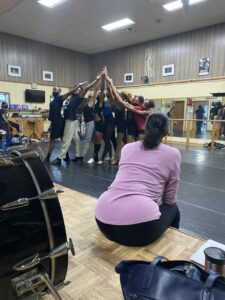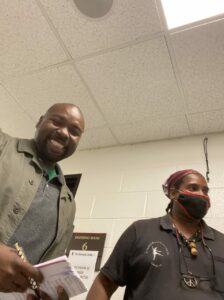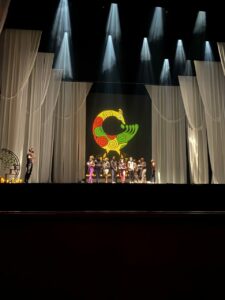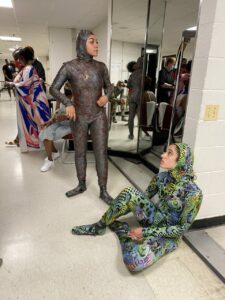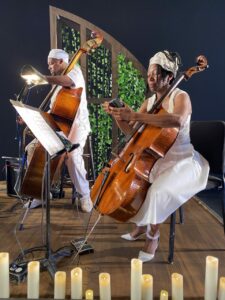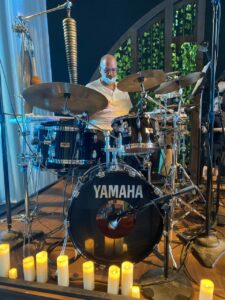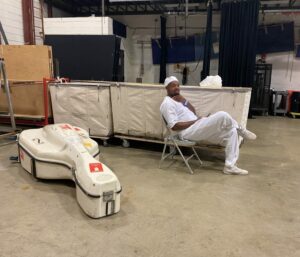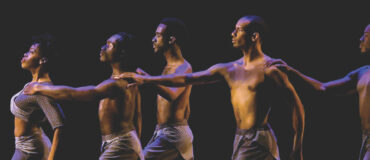by shady Radical
shady Radical is a 2022 Archiving and Preservation Fellow with Ballethnic Dance Company. Read more about the Fellowships here. This is the second part of shady’s blog. Find the first part here.
October 27, 2022: “Reframing the Narrative” at the Kennedy Center
In June 2022, Ballethnic Dance Company performed as part of Kennedy Center’s “Reframing the Narrative” program. This program included live performances, lectures, and workshops with dancers, choreographers, and scholars recognizing Black dance for its contributions to American culture. The program was curated by Theresa Ruth Howard, founder of Memoirs of Blacks in Ballet, and Denise Saunders Thompson, President and CEO of The International Association of Blacks in Dance. The curators selected Ballethnic, along with Collage Dance Collective, Dance Theatre of Harlem (DTH), and Donald Byrd to showcase excerpts from signature pieces, re-stagings, and commissions in two programs over the course of 5 days.
Arthur Mitchell and DTH seemed to be at the center of this constellation of Black dance. In a panel discussion with the choreographers and directors, Mitchell was credited with instilling a passionate responsibility to carry on his work in the people who would continue in his stead. Established in 1969, DTH was one of the few places people of color could go to learn, train, excel, and pursue careers in professional classical ballet despite popular belief that Black people could not dance ballet. Not only did Mr. Waverly Lucas and Ms. Nena Gilreath, the founders of Ballethnic, meet while dancing with the company in the 1980s, curator Theresa Ruth Howard, Collage founder Kevin Thomas, and current DTH director Virginia Johnson have all danced with the company at different times.

Archival installation in the Kennedy Center Opera House foyer.
As the archival fellow this was the perfect opportunity for me to witness the production process of a major project for Ballethnic Dance Company. I used a variety of methods to document this significant moment in the history of the dance company. In addition to conducting observations and taking notes, I used my cell phone to capture moving, still, and sonic material. I produced soundscapes, interviews, and oral histories with dancers, musicians, instructors, former members, curators, etc. I found and photographed objects associated with the production. And I used my sensorial body as a recording and processing instrument to gather data in different spaces (i.e. The Kennedy Center, the National Museum of African American History and Culture, The Watergate Hotel, Ubers, a cafe across the street, the Watergate Steps, REWIND lounge).
Prep
Prior to departing for Washington D.C. I watched the company practice and rehearse a number of times at Ballethnic. In the first rehearsal I observed the dancers studying performances of Sanctity together on a large flat screen television positioned in the corner of studio A. The recording was streamed from Ballethnic’s YouTube channel, where it was uploaded 10 years ago on August 24, 2012. In the beginning of the performance you can see Mr. Waverly leading a processional as Ms. Nena follows directly behind him. It was amazing to see how embodied material traveled from the founders to the current company dancers using technology.
The dancers would watch it, try it, rewind it, and repeat. Karla Tyson and Calvin Gentry led the practices by calling out the counts, where they would start from, and asking dancers to try it alone.
- Rehearsing Sanctity with Rehearsal Instructor Lydia Abarca Mitchell
- Rehearsal Instructor, Al Morrison giving feedback
- Royce Zachary, former Ballethnic student, with Mr. Waverly
The company also worked with rehearsal instructors Aldwana “Al” Morrison and Lydia Abarca Mitchell. Mr. Al is a former principal member of Donald Byrd’s The Group and Atlanta Ballet (1997-2005) and Ms. Lydia is one of the first dancers Arthur Mitchell hired for DTH in 1968. Abarca Mitchell (no relation to Arthur Mitchell) would eventually become the company’s first prima ballerina. During these rehearsals, I sat on the stage behind Mr. Al and Ms. Lydia as they took notes on paper, whispered to each other, and gave feedback on the look and feel of the performances. They would also demonstrate what a particular move should look like using their own bodies. Interestingly, Mr. Al would ask the dancers what the move was supposed to be or look like, get them to come to a consensus, and then work to synchronize them from an objective point of view. Ms. Lydia’s memories about seeing the live performances informed the affect and gesture the dancers were after. Since I noticed Mr. Al taking notes, I asked if I could see, have, or photograph them following the rehearsals. Unfortunately, these notes were quickly discarded after each rehearsal as it was considered nothing more than scribbling to remind him of what he was thinking at the time, but nothing worth being preserved. I begged to differ.
Sanctity and The Leopard Tale
Ballethnic presented Sanctity and excerpts from The Leopard Tale, two of the company’s signature pieces, at the Kennedy Center. Both pieces were choreographed by the company’s founder, Waverly T. Lucas. Ballethnic presented The Leopard Tale at Alliance Theater in Atlanta in April, which worked to prepare the piece for this production. I was lucky enough to take my daughter to a Sunday afternoon performance and experience a Ballethnic performance from a patron’s perspective prior to starting with the company as their archivist. My archival nerve was touched when I was reminded that no recording was allowed during the performance. While some excerpted and edited material is available on YouTube, it is nothing like seeing the real thing live. I left the show curious to know how they are keeping official records of these performances and if any material was preserved in its entirety for study. I could not wait to get started with the company.
- Dancers Imani Christopher, Saabirah Christopher, and Beatrice Polini
- Ms. Nena Gilreath, Kennedy Center rehearsal room
- Dancers rehearsing Sanctity with stage manager Matt Crowell
Sanctity was originally commissioned by Baba Chuck Davis for Dance Africa in 1999. The piece meditates on our relationship between the spiritual and ancestral realms. Each dancer presents an object, poem, and choreographic piece during this performance. The object is something that has a particular significance to them. Objects ranged from dolls to meditation instruments. Over the course of preparation, I pulled each dancer aside to talk about their object, as well as their dance background and current practice. I recorded these interviews and took pictures of their objects. However, due to the rigor of the schedule I was unable to get pictures of all of the objects.
In the last rehearsal before leaving for D.C., community members sat on the periphery of the studio, chatting quietly, and reminiscing about their experiences within these walls. This moment seemed valuable to a host of people beyond the walls of the room. As the dancers practiced the onlookers beamed with pride and support. Towards the end, Ms. Nena talked about how Black people move through space as being very specific and remembering the need to celebrate that. Mr. Waverly talked about how Sanctity was inspired by the Black church, wailers, community, and the spiritual connection with the ancestors. The room vibrated with energy as Atlanta headed to “The Nation’s Stage.”
Costumes
All of the costumes used for these performances were designed by Nyrobi Moss, an award-winning costume designer with 30+ years experience. For The Leopard’s Tale, dancers wore animal print bodysuits perfectly tailored to their bodies. Calvin and Karla wore costumes of the Leopard and the Leopardess, while the rest of the group wore snakeskin bodysuits for the Spasms piece in which dancers performed as snakes. One of the dancers, Imani Christopher, also a student at Clark Atlanta University studying fashion design, decorated the ballet slippers. Recently, she has become known as the resident ballet slipper designer, as well as costume assistant, on major productions (i.e. Urban Nutcracker).
For Sanctity, the costumes were re-made for the Kennedy Center performance. Long, white, voluminous pieces trimmed in gold emphasized movement and flow-etry as dancers floated through space and across the stage. It reminded me of adornment practices, regalia, and sacred rituals in West Africa, particularly agdabas and geles. Agdabas are Nigerian ceremonial robes typically worn by men of the Yoruba tradition for weddings and funerals and Geles are headdresses worn by women. These costumes presented a strong aesthetic departure from clothing usually seen in ballets, but appeared perfectly natural on women dancing en pointe and men lifting male and female bodies with ease.
- Dancers Maurissa Powell and Beatrice Polini getting fitted for costumes at the Kennedy Center
- Costume Designer Nyrobi Moss fixing dancer Calvin Gentry’s costume
Music
Mr. Gerald L. Reid composed the music for both Sanctity and The Leopard Tale. Sanctity included a live musical performance with three musicians, while The Leopard Tale used a pre-recorded track. In Sanctity, Mr. Reid played the drums alongside cellist, Ms. Marla Majett and bassist, Mr. Dishan Harper. In an interview with the composer, he and his wife, Ms. Vivian Reid, recalled the fun they had walking around their backyard searching for new sounds for their musical composition. Known as “foley art” in filmmaking and TV production, this creative process introduced new challenges for the hired musicians of live performance. Not only were the musicians required to learn the music, choreography, and take cues from the dancers, but they also played with a track created to supplement the instrumentation. The three musicians appearing in the background of Sanctity, sitting on an enlarged version of the altar downstage right, was a striking visual presentation of jazz aesthetics, however, it was also deceptive in the labor and complexity involved in creating something appearing so raw, unencumbered, pure, natural, and organic.
At different times, I interviewed each of the musicians. During these conversations we talked about their personal backgrounds, professional experiences, how they felt about playing at the Kennedy Center with Ballethnic, their current musical practices, and their futures.
- Bassist Dishan Harper and cellist Marla Majett preparing to perform Sanctity
- Mr. Gerald L. Reid, composer and musician for Ballethnic
- Bassist, Dishan Harper waiting in the wings of Kennedy Center
Archive
In an attempt to meet more archivists and learn about preservation in the D.C. area, I reached out to my friend Holly Smith, archivist at Spelman College, to see if she knew any archivists working in the area. She connected me with Shauna Collier and Ja-Zette Marshburn, archivists at the National Museum of African American History and Culture, and Sofia Becerra, archivist at the Kennedy Center. In a conversation with Becerra, I learned how the current state of the archive and her job specifically are part of a preservation initiative for the organization’s landmark 50th anniversary. She also explained how closely they work with marketing and public relations in providing archival material for upcoming events. For example, photographs of past performances were printed in large formats and presented on the facade of the balconies in the Opera House Foyer and performance programs were reproduced and configured into the number 50 in the Great Hall in celebration of the 50th year anniversary of the Kennedy Center.
Accompanying Ballethnic as their archivist helped develop my radical archiving practice. Black production and performance practices tend to move at a slightly faster pace due to the relationship between productivity and racial capitalism. These creative and cultural producers are required to rely on embodied knowledge to adjust, pivot, and move through spaces to keep pace with the demands of capitalism. With less resources, space, time, care, and consideration, Black bodies, in particular, negotiate visibility in order to produce, perform, and fulfill their obligations. These performances present as stillness, silence, agility, and speed depending on the environment and forces present. Originating as modes of survival developed during the transatlantic slave trade, these black codes and movement practices are ontologically anarchival and undocumented. Therefore, these artists do not produce as much physical material to correspond to the knowledge they are making, using, and sharing between them. So as an accompanying archivist, I used tools of documentation and radical methods of preservation to capture the archival material flowing in the spaces, in the bodies, and between the bodies to add tactility to this information.

Dancers Saabirah Christopher, Imani Christopher, Karla Tyson, Calvin Gentry, Demetrius Tuckery and Beatrice Polini at _Reframing the Narrative_ toast in Kennedy Center
Other Highlights and Moments of Significance
- Visiting the National Museum of African American History and Culture with Mr. Waverly Lucas, Ms. Nena Gilreath, Mr. Adam McKnight, and Dishan Harper
- Walking to the Watergate Steps with Dishan Harper
- Dinner with Ballethnic, hosted by Imara Canady
- Cafe chat with Kellee Edusei, Mr. Waverly, Ms. Nena, and Mr. Adam McKnight
- Tagging along for television show segments
- Talk with Dr. Dunnar and Mr. Waverly
Top photo: Finale bows Urban Nutcracker Act II (Cast). Photography by Sirk Photography. Courtesy of Ballethnic Dance Company. All other photos courtesy of the author.
 shady Radical is a performance archivist and founder of The Radical Archive of Preservation. Her practice is grounded in ritual, resistance, and movement practices. She uses exhibition and performance to pull anarchival material out of traditional archives and historical memory to activate silences and erasures attributed to forms of subjugation.
shady Radical is a performance archivist and founder of The Radical Archive of Preservation. Her practice is grounded in ritual, resistance, and movement practices. She uses exhibition and performance to pull anarchival material out of traditional archives and historical memory to activate silences and erasures attributed to forms of subjugation.
As a Fellow, shady looks forward to working with a nationally recognized southern institution committed to expanding access to professional dance opportunities for people of color. By combining ballet with African dance and other forms, Ballethnic directly contributes to the Black cultural production shady is most interested in studying, knowing, and preserving.
shady earned a M.A. in Curatorial Studies from New York University and B.A. in Art History from The College of Saint Elizabeth. Her professional experience includes working at Tyler Perry Studios, Atlanta Contemporary, and Assistant Chair for Society of Georgia Archivists’ Education Committee. shady is a Ph.D candidate at Georgia State University.
____
We accept submissions on topics relevant to the field: advocacy, artistic issues, arts policy, community building, development, employment, engagement, touring, and other topics that deal with the business of dance. We cannot publish criticism, single-company season announcements, and single-company or single artist profiles. Additionally, we welcome feedback on articles. If you have a topic that you would like to see addressed or feedback, please contact communications@danceusa.org.
Disclaimer: Opinions expressed in guest posts do not necessarily represent the viewpoints of Dance/USA.


